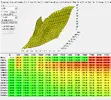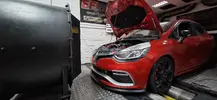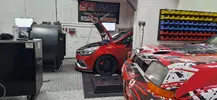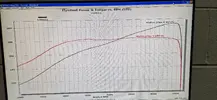254 (Renaults are great at disappointing)
There is more to life with TurboRenault.co.uk
You are using an out of date browser. It may not display this or other websites correctly.
You should upgrade or use an alternative browser.
You should upgrade or use an alternative browser.
Steve Swan
Well-Known Member
272..... was the fuel pump change to give same pressure at higher flow rate or higher on both. Is it on std injectors? What is their limit? Is it dependant on the fuel pump? I guess it must be. So many questions, so little time...
Higher flow at the same pressure. The in tank pump is fixed at 5bar and feeds a high pressure fuel pump and direct injection injectors. The info I was given from @tutuur is that the stock in tank pump will be flat out at around 285bhp, hence the higher flow pump. The hpfp and injectors will be maxed up near 320ish bhp.272..... was the fuel pump change to give same pressure at higher flow rate or higher on both. Is it on std injectors? What is their limit? Is it dependant on the fuel pump? I guess it must be. So many questions, so little time...
Steve Swan
Well-Known Member
Ok. Also a slight drop in fuel pressure will have the effect of weakening off the mixture which is a sure route to disaster. I take it you ( the mapper) can adjust the timing and length of injector on, plus the size and flowrate of the injectors in question, plus the fuel pressure versus any extra boost pressure which fights against fuel pressure.... All have to be corrected/ correct to get the desired effect IE. Maximum power.
It's not commonly known, but each carburettor phase has a fuel supply to jets. Idle, progression and mains. These come in and out as required depending on throttle position and vacuum in the manifold, plus there is a pump circuit to richen the mixture on acceleration. Once the throttle is wide open and the engine at full cry it pulls fuel from everywhere,idles pumps, mains, progression holes. This is why there's an air correction jet which is used to weaken the mixture more at the top end. What I'm trying to say in a long-winded way is that it self adjusts very well once it is dialled in. Does an ecu have similar correction features or does it all have to be programmed in???
It's not commonly known, but each carburettor phase has a fuel supply to jets. Idle, progression and mains. These come in and out as required depending on throttle position and vacuum in the manifold, plus there is a pump circuit to richen the mixture on acceleration. Once the throttle is wide open and the engine at full cry it pulls fuel from everywhere,idles pumps, mains, progression holes. This is why there's an air correction jet which is used to weaken the mixture more at the top end. What I'm trying to say in a long-winded way is that it self adjusts very well once it is dialled in. Does an ecu have similar correction features or does it all have to be programmed in???
The ecu can do all of that and more from factory. The car can be driven in pretty much any climate and any altitude and make the corrections as so you notice very little difference.
Chris at EFI should have full control to adjust the ecu for where he needs the fuelling, ignition timing as well as adjusting both cams (variable on both inlet and exhaust) and boost pressure.
Chris at EFI should have full control to adjust the ecu for where he needs the fuelling, ignition timing as well as adjusting both cams (variable on both inlet and exhaust) and boost pressure.
Brigsy
Media Mogul. Instagram legend.
I like the sound of vvt on both cams.
@Steve Swan on modern ecus your in control of everything, they are fantastic in comparison to any old carburettor/distributor setup. Corrections sometimes need to be adjusted but are all in the background.
For me, going from carburettor/fixed ignition curve to electronic fuel injection unleashed so much potential on my c1j as lots more control, giving it fuel and ignition where needed.
@Steve Swan on modern ecus your in control of everything, they are fantastic in comparison to any old carburettor/distributor setup. Corrections sometimes need to be adjusted but are all in the background.
For me, going from carburettor/fixed ignition curve to electronic fuel injection unleashed so much potential on my c1j as lots more control, giving it fuel and ignition where needed.
Duncan Grier
Well-Known Member
292bhp as its colder up north and lower charge temps 
Steve Swan
Well-Known Member
What I am wondering is if the mixture is weak at a certain point in the rev range, how do you go about richening it. Increse fuel pressure ? increase injector on time?? Upping pressure will richen through the range, so not a good idea . I'm also thinking that the injector is probably not just a single squirt, but may be in several phases, so thats how the changes are made??
I was through at the rolling road with my old mate Mike with an 1800 Alfasud motor in a Ginetta G15, to see if any more power could be found. It runs Dellorto Downdraughts and the jets are a bit peculiar on them , but Mike probably has the best selection of Jets in Scotland . Long story short no gains were made as it had a very strange Correct-Weak-Correct thing in the Lambda readings We went down on air correction, but predictably it went Correct-weak-Rich ,so no good then. After a couple of other changes it looks like the Engine hates its exhaust manifold as it's not a crossover type it just wont scavenge properly between 3000-5000 then it's away.
After coming to this conclusion and then speaking to the young guy who was operating the road for us (he won't touch carbs) he went back through his files on the computer and found us a new Subaru plot (which was a non turbo I am sure) Guess what it had the exact same issue in the same place and the young lad said the cure was a different manifold , so modern tech or not car Manufacturers still let absolute rubbish out there with design faults.
Carbs and turbos don't mix and the ign requirement is probably double that of an Atmo. Esp if you want some economy when cruising. The rules never change though the Bang should happen at 13 degrees after tdc. If you got all the sums correct the maximum amount of advance you need to add is about 28 degrees from tdc at max Revs and full throttle , I would think 3-5 degrees less on a turbo due to the higher cylinder pressure. How you fill in the bit between idle and there, is quite varied. Am I barking up the wrong tree ? can correction be done on ign only as an ecu allows you to move the ignition around in a way a dizzy cannot. I know I have not got my 1700 quite right as it is set at 30 Degrees Max , so it's a bit shy of cylinder pressure valves may be a half mil low or similar, costing me that last smidge of compression.
I always laugh to myself when people see the sidedraughts and comment on the lack of fuel economy. Not so. All my Race motors did around 30MPG when cruising. Ive yet to try the 1700, but If it won't make 30 on a run we'll revisit the idle circuits until it does.
Sorry to clog up your thread @Adey . It's the curse of being born curious ..............
I was through at the rolling road with my old mate Mike with an 1800 Alfasud motor in a Ginetta G15, to see if any more power could be found. It runs Dellorto Downdraughts and the jets are a bit peculiar on them , but Mike probably has the best selection of Jets in Scotland . Long story short no gains were made as it had a very strange Correct-Weak-Correct thing in the Lambda readings We went down on air correction, but predictably it went Correct-weak-Rich ,so no good then. After a couple of other changes it looks like the Engine hates its exhaust manifold as it's not a crossover type it just wont scavenge properly between 3000-5000 then it's away.
After coming to this conclusion and then speaking to the young guy who was operating the road for us (he won't touch carbs) he went back through his files on the computer and found us a new Subaru plot (which was a non turbo I am sure) Guess what it had the exact same issue in the same place and the young lad said the cure was a different manifold , so modern tech or not car Manufacturers still let absolute rubbish out there with design faults.
Carbs and turbos don't mix and the ign requirement is probably double that of an Atmo. Esp if you want some economy when cruising. The rules never change though the Bang should happen at 13 degrees after tdc. If you got all the sums correct the maximum amount of advance you need to add is about 28 degrees from tdc at max Revs and full throttle , I would think 3-5 degrees less on a turbo due to the higher cylinder pressure. How you fill in the bit between idle and there, is quite varied. Am I barking up the wrong tree ? can correction be done on ign only as an ecu allows you to move the ignition around in a way a dizzy cannot. I know I have not got my 1700 quite right as it is set at 30 Degrees Max , so it's a bit shy of cylinder pressure valves may be a half mil low or similar, costing me that last smidge of compression.
I always laugh to myself when people see the sidedraughts and comment on the lack of fuel economy. Not so. All my Race motors did around 30MPG when cruising. Ive yet to try the 1700, but If it won't make 30 on a run we'll revisit the idle circuits until it does.
Sorry to clog up your thread @Adey . It's the curse of being born curious ..............
DaveL485
Staff member
Looking at my old map file from the 21 you're not too far off.If you got all the sums correct the maximum amount of advance you need to add is about 28 degrees from tdc at max Revs and full throttle

On an EFI car the gadgetry does it itself, unless you tell it not to. I think the first generation of this Renault wise was the 21 Turbo era, I have press releases where they call it out as a 'feature' that the engine management could cater for different altitudes and temperatures very effectively. Todays modern kit will have a number of tools at its disposal to adjust, around fuelling, ign timing, valve timing (and lift in some cases but I dont believe Renault have done that yet).What I am wondering is if the mixture is weak at a certain point in the rev range, how do you go about richening it
Mk4 RS's have the M5M engine and the direct injection pressure runs over 2000psi I believe (correct me if im wrong anyone), so i suspect it doesnt give a shit about an increase in manifold pressure, I think though if the tank pump can't supply enough to the DI system with the raised delivery requirement once mapped it could get quite nasty. Otherwise it has all the parameters above at its disposal to essentially run closed loop fuel and ignition to a point. They have a crazy amount of sensors to keep everything in check. I changed an engine in a 2016 Kadjar recently and it had THREE knock sensors and that was only a little 4-pot 1.2 turbo.I'm also thinking that the injector is probably not just a single squirt, but may be in several phases, so thats how the changes are made??
Todays the day, check back for updates!!
Norwich Nick
Well-Known Member
I’ve absolutely no idea numbers wise, I’m just along for the ride 
Hope it makes good numbers, hopefully you’ll continue to tinker as I’ve always found your projects interesting
Hope it makes good numbers, hopefully you’ll continue to tinker as I’ve always found your projects interesting
Steve Swan
Well-Known Member
It's all gone quiet...................
Steve Swan
Well-Known Member
You'll be quite pleased with yourself. Rightly so..
Similar threads
- Replies
- 126
- Views
- 2K
- Replies
- 0
- Views
- 25





